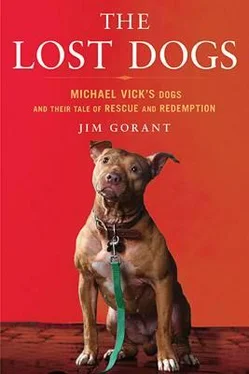She had long ago learned to put aside her sentimentality and compassion so that she could focus on the science of her job. She was helped by the knowledge that what she discovered would help deliver justice to the people who were cruel to animals and save other creatures from the same fate.
After the raid, the dead dogs that were recovered had been loaded into the van, and two USDA agents drove them to Merck’s offices in Atlanta, so they were never out of direct custody. By the time they completed the fourteen-hour trek, Merck was there in her lab waiting for them.
The Vick dogs presented a daunting challenge. Ideally, she would have been on scene at the original raid to document everything from where each dog was kept to the condition of the water in the bowls to the temperature. Had she been present then, she would have carefully sketched, photographed, and charted the entire scene. She would have combed the fur for evidence and examined the bodies inside and out for damage. Instead, she was faced with one dog that had never been uncovered and eight that had already been dug up once, which disturbed the purity of the site and the bodies, and accelerated the decomposition process.
Her initial examination of the bodies confirmed what she had expected to be the case: only three dogs had enough flesh remaining to perform an external examination. For the rest she could do only a skeletal analysis. A dog has 321 bones in its body, and each bone would need to be labeled, catalogued, and studied under a microscope, a process that would likely take weeks. Time was running short.
NFL training camps were only a few weeks away. In private meetings Vick had assured league commissioner Roger Goodell and Falcons owner Arthur Blank that he had not been involved in whatever was going on at the house. They had taken him at his word, but for the rest of the world there was an urgency to know if Vick would be there when the season began. For some Falcons fans it was unthinkable that he would not be, but for animal lovers and those who suspected the worst, the idea of Michael Vick out on the field being cheered by thousands of people while collecting millions of dollars was repulsive.
Merck was aware of the controversy, so she did the only thing she could. One by one, she lowered each carcass into a vat of hot water that reduced it to nothing more than a pile of bones.
AS JULY STRETCHED ON and the investigation moved toward its pinnacle, Jim Knorr and Bill Brinkman realized they had a dog problem. Or was it a man problem? Brownie continued to be a thorn in Knorr’s side. He called too much; he didn’t call at all. He showed up where he wasn’t supposed to; he disappeared. Brinkman and Knorr were constantly dealing with Brownie. Driving him back to Virginia Beach, moving him from one hotel to another, scraping together money out of their own pockets to keep him full of McDonald’s and Wendy’s. Now, as things were getting serious, Knorr planned to send Brownie to a safe house in Florida.
The thought of a trip to the Sunshine State didn’t do much for Brownie. He remained irascible. He did what he wanted, which kept Knorr up at night as much as the phone calls. Among the things Brownie wanted was his pooch. One of the dogs in Vick’s compound, a giant male presa canario, belonged to him, but it had been taken away with the rest. Knorr thought if he could get the man’s dog back, maybe Brownie would be so grateful that he’d be more cooperative.
Finally, after months of trying to spring the dog through legal channels, Brinkman and Knorr took matters into their own hands. They finagled some paperwork and showed up at the shelter where the dog was being kept, flashed their badges and the letter, and walked out with the dog. Problem solved. At least for one dog.
The forty-nine pit bulls that were now the property of the federal government were a different story. The forfeiture statutes that had been used to seize the dogs gave the court a role in deciding what would become of them. Gill and the other attorneys knew that judges preferred to receive some sort of guidance or suggestion about how to rule when odd things like this popped up. The natural inclination is to look at what has been done in the past and use that as a precedent, but since dogs from fight busts are usually put down, that was a bleak alternative.
To the surprise of many, this was exactly the course prescribed by some of the loudest voices in animal welfare. Wayne Pacelle, the president and chief executive of the Humane Society of the United States, told the New York Times he thought the dogs would and should be destroyed. “Officials from our organization have examined some of these dogs and, generally speaking, they are some of the most aggressively trained pit bulls in the country. Hundreds of thousands of less-violent pit bulls, who are better candidates to be rehabilitated, are being put down. The fate of these dogs will be up to the government, but we have recommended to them, and believe they will eventually be put down.”
PETA took an equally dim view. “These dogs are a ticking time bomb,” a spokesperson for the organization said. “Rehabilitating fighting dogs is not in the cards. It’s widely accepted that euthanasia is the most humane thing for them.”
The assistant district attorneys in the office of the Eastern District of Virginia weren’t sure they agreed. Gill brought it up one day in a conversation with Merck and she got the sense that he was not terribly concerned about what had been done in the past or what outside forces thought should happen. He seemed to feel that a lot of those experts were more interested in getting their names in front of the public to spur donations than they were in the welfare of the dogs.
Gill didn’t even have any idea what the rehabilitation options were, but he wanted to know. Merck suggested he speak with Dr. Stephen Zawistowski, the ASPCA’s top behavior expert. At fifty-two Zawistowski, known universally as Steve Z or Dr. Z, was stout with white hair, a bushy white beard and mustache, rimless glasses, and apple cheeks. Affable and avuncular, he peppered his speech with thoughtful tugs at his facial hair and spiced up his outfits with ties that had flying doghouses and cat prints on them. He was the animal rescue world’s Santa Claus. Santa Claws, maybe.
With a Ph.D. in behavior genetics and a specialty in animal psychology, Dr. Z could bring the combination of science and compassion that Gill sought. In twenty years at the ASPCA Dr. Z had tackled everything from pet overpopulation to issues of behavior and welfare. During that period he’d risen from vice president of education to executive vice president of national programs and science advisor. The twenty books he either authored or edited included a history of the ASPCA, and he was fond of telling tales of the organization’s flamboyant founder, Henry Bergh, who got his start breaking up illegal dogfighting and bear-baiting exhibitions in lower Manhattan in the 1870s.
Gill first approached Dr. Z in early July about other possible outcomes for the dogs. Dr. Z said there was some chance that a few of the dogs could be salvaged, but there was no way to know without meeting them face-to-face. It was possible, he suggested, to put together a panel of experts to individually evaluate each dog and make suggestions about what should become of them.

Even as Gill plotted a course for the live dogs, Melinda Merck continued to focus on the dead ones. Within a week of receiving the bodies, she gave Gill a preliminary report of her findings. It was good news. Most of what she found backed up Brownie’s account. The insect evidence-the fly larvae, the maggots, the flies themselves-indicated that the dogs had been in the ground for about two months. Almost every dog had little puncture marks or scoring on the bones, especially on their legs and faces, that indicated they had been bitten by other dogs. Based on the depth of the markings, the other dogs had most likely been pit bulls. Even more damning were the preponderance of facial fractures, which almost always resulted from fighting. And a few of the dogs had broken necks, which suggested hanging.
Читать дальше













